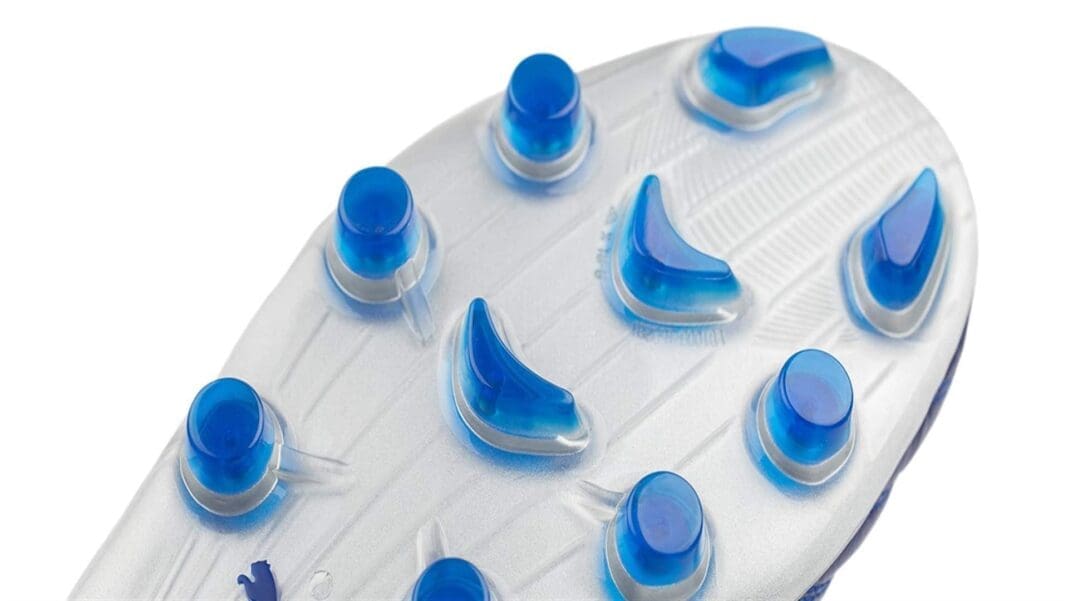JayC (nosajpersonlah) takes you through the lesser known world of HG boots that are all the rage in Japan.
Artificial turf is getting more popular worldwide due to its ever reducing costs to set up and its minimal effort by groundsmen to maintain it through all weather. Its popularity has sparked demand for a new type of soleplate – one that works not just on firm natural ground but also the more harsh and shallow artificial ground.
For more about choosing the right boots for each ground type, you can read our guide here.
With many studies linking the usage of firm ground studs on AG pitches with injuries, consumers were caught in a new dilemma. Do they purchase 2 pairs of boots for different ground types or just risk it and use the popular firm ground (FG) stud pattern on artificial grass (AG). The latter was a common choice for most players which gave rise to claims of poor durability, to the effect that brands began announcing that using FG boots on Artificial Grass fields would void your warranty.
Rise of The FG/AG Soleplate
Brands soon went on the counter-offense, introducing FG/AG stud patterns (adidas, Mizuno and Puma), or even AG stud patterns that also work on FG (Nike). Without jumping into technicalities, a large problem of FG/AG boots is that it’s a walking contradiction.
For starters, unless the AG surface you’re playing on is of a high quality, a stud that can give you enough grip in a softer firm ground surface is going to give you too much grip on a harder AG surface which could cause injuries.

Another factor to also consider is that the push towards lighter boots have also resulted in thinner soleplates. Even if stud pressure is not really an issue, the thinner soleplates are less durable under the intense heat and pressure generated from an AG surface which is harder than natural ground.
Enter the Hard Ground (HG) soleplate to stake its claim as the “World’s Most Versatile Soleplate’.
Hard.. Ground? Only in Japan.
These are just some Japan-specific items that have since been exported to the wider world out there. Hard Ground soleplates, however, are still mainly sold in Japan, because they fulfil a very specific playing surface that is found mainly in Japan. Yeap, you guessed it, a Hard Ground field, which is mostly made of sand.

Before the prevalence of Artificial Turf, a large number of Japanese football training fields tend to be harder and filled with soil and sand, which led to a lot of stud pressure. The abrasive nature of the stud pattern also meant that typical Firm Ground studs had a tendency to grind very quickly or even break.
As such, a lot of the boots that were sold in Japan tended to be customised into a Hard Ground (HG) soleplate, even till today. Both Nike and adidas for example, customise special Hard Ground soleplates for their internationally available boots. Nike’s HG soleplate, for example, even adds in a single rivet, for that extra durability.
Take a closer look at the stud configurations of the boots and you sort of get what the HG soleplate is meant for. Because of how firm Hard Ground surfaces tend to be, HG soleplates tend to use a larger number of studs than your typical FG patterns, to better distribute pressure to prevent stud pressure. They are also shorter to prevent excessive pressure being applied on the stud and causing it to break.

They also tend to favour rounded studs, because it allows for better manoeuvrability and reduces the chances of injury from the studs getting caught in the ground. Lastly, you’ll notice most HG stud patterns don’t have the conventional ‘spine’ in the center of the soleplate to increase rigidity there, unlike a good number of FG plates. This is because they tend to already be pretty thick and stiff in the first place, to deal with the abrasiveness of the hard ground surface. For reference, the Tiempo Legend 7 HG weighs in at nearly 245 grams, a whole 50grams heavier than its FG counterpart.
For wider footed players like myself, HG soleplates are in your favour as well, because the Japanese foot shape tends to be wider in the forefoot and the soleplates reflect that. I’ve constantly heard about the break-in time required for the Nike Tiempo Legend 7 FG due to the Chinese flytrap system and the internal foam cage. However, I had no problems in my HG Tiempo Legend 7 as the soleplate was wider and fit my foot better, which meant my foot did not feel as constricted and reduced the break in time required.
The Argument For HG Boots On AG Surfaces
While some of the more ‘modern’ HG stud patterns have begun incorporating non-rounded studs, they tend to not be as aggressive as the FG studs, and are often in places that are less likely to get stuck, such as the toepick stud for acceleration, or in the heel.

These same characteristics also lend itself to a successful AG soleplate, eliminating durability and injury concerns in one fell swoop. Most of the time, brands also add in rivets to further reduce the possibility of the soleplate splitting. The combination of extra studs, a thicker soleplate and poron inserts in the insoles further help to reduce the amount of stud pressure one might feel.

On slightly softer FG surfaces, you might encounter some slipping, but like I said earlier, something’s gotta give with a versatile soleplate. In this case, you forego that extra bite and grip when pushing off and sprinting. Players who favour a lightweight boot should look away as these boots tend to be heavier, although some brands such as Gavic are producing slightly lighter soleplates which mean that their boots are still able to weigh around the 200g mark. Personally, as someone who plays centrally, I do enjoy the oomph that a 240g boot gives me when pinging the ball to my wingers so I see it as a plus.
At the end of the day though, it really all comes down to personal preference. But if everything you’ve read here ticks your boxes for an FG/AG boot, I suggest taking a trip down to Tokyo soon, you won’t regret it.




[…] hard ground soleplate (read more about HG soleplates) felt right for artificial ground (AG) and also on firm natural ground (FG). It’s not the most […]
[…] explains the production of the rubberised lip to prevent wear and tear, as well as rivets on most HG outsoles. In a world where having a boot that lasts a full season is considered ‘durable’, the Japanese […]